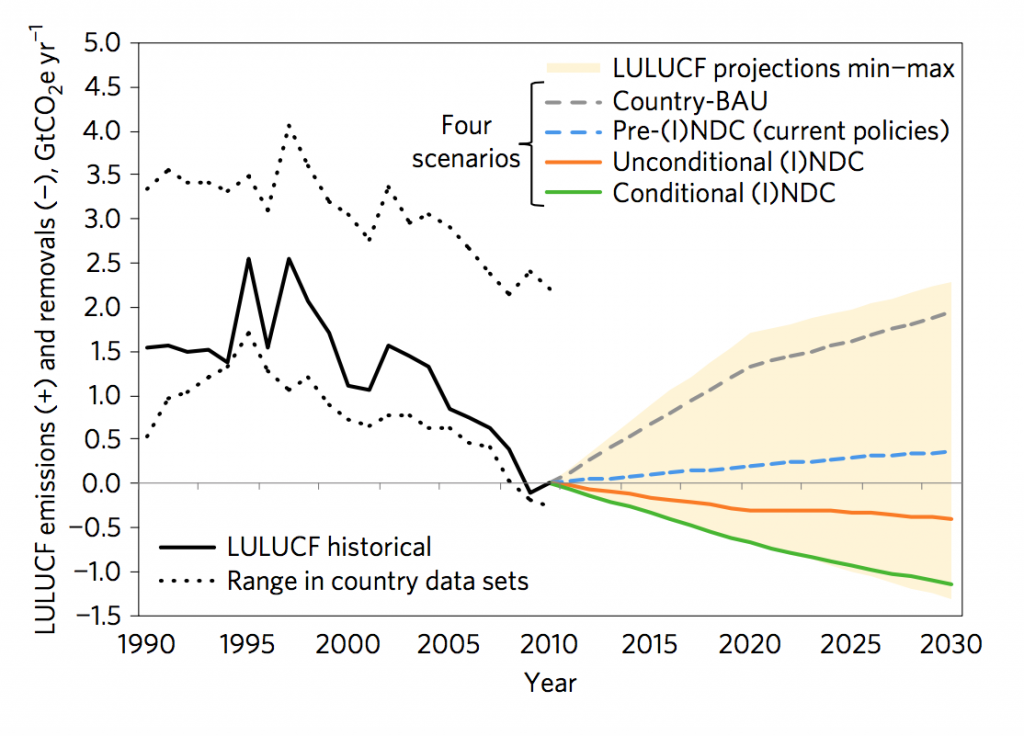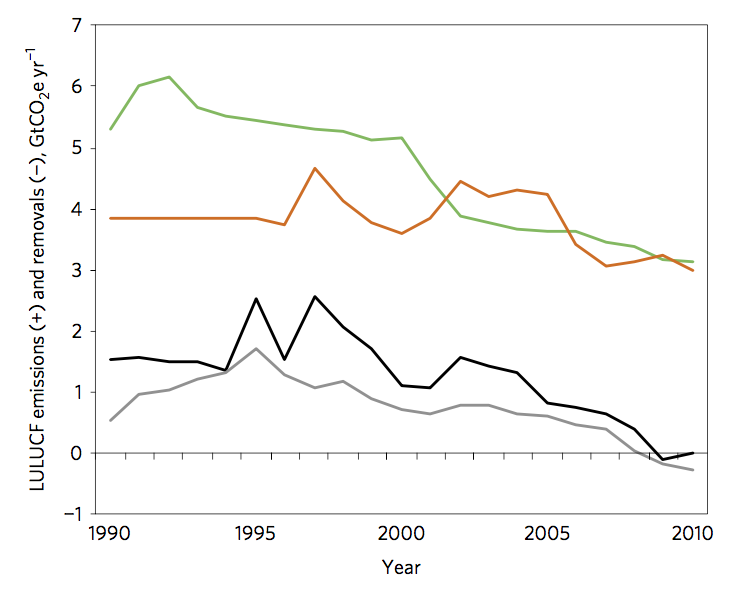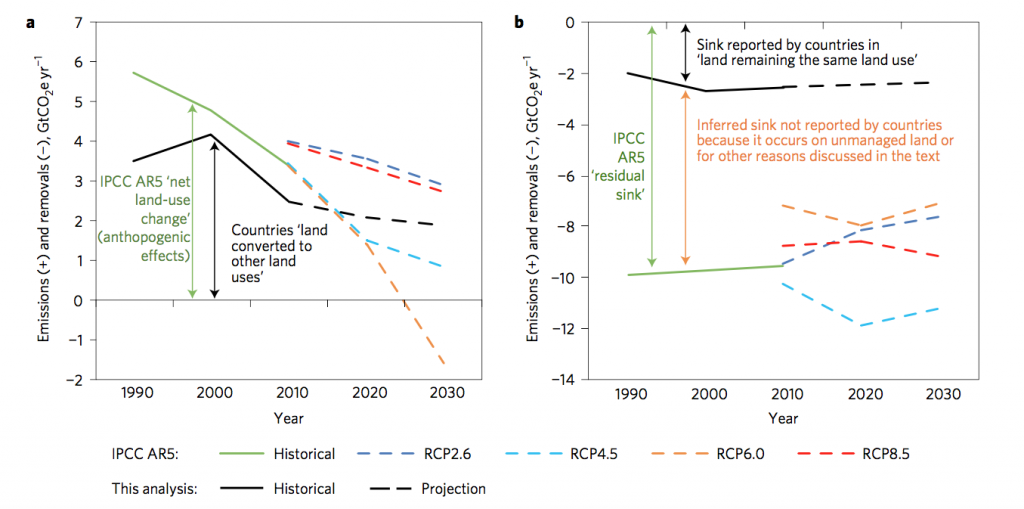
Guest Post: Forests to provide a quarter of Paris Agreement’s pledged mitigation
Multiple Authors
02.27.17Multiple Authors
27.02.2017 | 4:01pmThis is a guest post by Dr Jo House, reader in environmental science and policy at the University of Bristol’s Cabot Institute, and Dr Giacomo Grassi, scientific officer at the Joint Research Centre of the European Commission.
The Paris Agreement on climate change set new targets for the world. Notably, it called for warming to be limited to “well below” 2C and for carbon neutrality (“net zero”) by the second half of this century.
Forests play a major role in the pledges made by countries towards meeting the Paris targets. Our analysis, published today in Nature Climate Change, shows that countries expect the land sector to provide a quarter of their pledged mitigation efforts up to 2030.
Accurately measuring the role of the land sector in achieving the long-term goals of the Paris Agreement relies on consistency between the data submitted by individual countries and independent scientific assessments. If these numbers don’t match, it can undermine confidence in assessing progress toward the “below 2C” target.
Bringing together the science and policy communities will improve transparency and confidence in mitigation efforts.
Why is the land sector important and why is it hard to measure?
Human land-use change and land management accounts for about 10% of anthropogenic CO2 emissions (mainly through deforestation) and about a quarter of all our greenhouse gas emissions (including agricultural livestock emissions and the use of fertilisers).
At the same time, the land acts as a sink, soaking up about a third of emitted anthropogenic CO2. The land sink is essential in meeting strong mitigation targets, especially with projected scenarios heavily reliant on large-scale avoided deforestation, afforestation and “negative emissions” technologies, such as bioenergy with carbon capture and storage (BECCS).
Mitigating our CO2 emissions using the land, such as avoided deforestation and sustainable afforestation, can have many added co-benefits. These include protecting or enhancing biodiversity, supporting the hydrological cycle (“rainfall recycling”), preventing erosion, enhancing flood control and maintaining access to other forest goods and services.
Yet it has been a long and complex process to create policy and methods to monitor, assess and incentivise land-based greenhouse gas mitigation. Methods and approaches differ widely both across and within policy and science domains.
Measuring the impact that humans have on how much CO2 the land emits or absorbs (the CO2 “flux”) is tricky. This is because of a lack of data on land-cover change and carbon stocks. It is also due to the difficulties separating and attributing what fluxes are directly due to human activity, and what are part of the natural response of growth and decay to environmental conditions and environmental changes. Thus, the anthropogenic CO2 land flux is the most uncertain part of the carbon budget.
How much will the land sector contribute to the Paris Agreement?
In preparation for the Paris negotiations in December 2015, countries submitted their intended nationally determined contributions (INDCs). Nearly 100 countries explicitly mentioned a mitigation role for the “land use, land use change and forestry” (LULUCF) sector.
We analysed official information provided by countries on the mitigation role of the LULUCF sector out to the year 2030. This included countries’ historical data and projections taken from INDCs, and from official communications under the United Nations Framework Convention on Climate Change (UNFCCC), such as greenhouse gas inventories. From this, we created four projected emissions pathways:
- Country-stated “Business as Usual” (BAU) scenario. Note: several countries use the term BAU to indicate a “no measures” scenario (i.e. ignoring policies that are already in place).
- Pre-INDC or “current level of activity” scenario. Based on policies and pledges that were in place prior to the INDC pledges (e.g. Cancun pledges, Brazil’s current forestry policy).
- INDC unconditional implementation. What countries have committed to do in their INDC as a minimum.
- INDC conditional implementation. What countries have committed to do in their INDC conditional on receipt of finance, etc.

Global LULUCF net greenhouse gas flux for the historical period and future scenarios based on analyses of countries’ documents and INDCs. Source: Grassi et al. (2017)
The approach to calculating the LULUCF contribution can result in very different estimated mitigation in 2030, depending on the way that mitigation is calculated. The range in each of the four cases represents the difference between unconditional to conditional pathways, rather than a measure of uncertainty:
- 1.2 to 1.9 GtCO2e/y (gigatonnes of carbon dioxide equivalent per year) in 2030 compared to 2005 emissions.
- 0.8 to 1.5 GtCO2e/y compared to “current activity” or “pre-INDC” reference scenario.
- 2.4 to 3.1 GtCO2e/y compared to country stated “BAU” reference scenario.
- 3.1 to 3.8 GtCO2e/y based on the approach used by each country to calculate its LULUCF contribution, which may be either one of the three methods above, or their own different method.
Of these approaches, the first represents the changes in the flux to the atmosphere over that time period and is closest to what would be calculated in a scientific assessment of mitigation effort.
However, in order to incentivise countries to take action and reward them for efforts, it has been necessary to provide some flexibility in the way countries may consider mitigation in their accounting. Thus, for example, Indonesia can take credit for the success of its reduced deforestation policies when compared with BAU in 2030, and Russia will likely account for the full sinks in its “managed” forests (irrespective of the fact that only part of that is directly human-caused).
We compared the mitigation policies specific to LULUCF to the mitigation efforts set out for all sectors combined. We found that, globally, the LULUCF sector is expected to contribute around 25% of all the emissions reductions in the INDCs.
What are the differences between science and policy approaches?
Even across the Intergovernmental Panel on Climate Change (IPCC), there are large differences in LULUCF emissions estimates.
For example, the UNFCCC reporting by countries is based on IPCC Good Practice Guidance methods, which differ from the independent scientific assessments used in the IPCC fifth assessment report, known as AR5. These also differ from FAOSTAT estimates. The differences are due, in part, to different definitions and methods as the approaches were developed for different purposes. Differences between UNFCCC and FAOSTAT include the definition of forest, coverage of areas and of carbon pools, and differing estimation methods by reporting agencies.

Comparison of historical LULUCF net greenhouse gas (GHG) flux from our analysis and other key global LULUCF datasets: country reports to UNFCCC (grey line); FAOSTAT (orange line); net land-use sector CO2 anthropogenic flux included in IPCC AR5 (green line); our analysis (black line) using a combination of data from countries’ sources (in order of priority: INDCs, 2015 GHG Inventories, recent National Communications; other official countries’ documents; FAO-based datasets). Source: Grassi et al. (2017)
A large difference between UNFCCC reporting and AR5 relates to the attribution of sinks in “forest land remaining forest land”. IPCC AR5 methods [pdf; pdf], based primarily on the Houghton bookkeeping model (see the Global Carbon Project for more details), focus on afforestation and deforestation with very limited forest management.
When we compare AR5 to UNFCCC “land converted to other land uses” only, the results are more similar (the figure below). In AR5, the UNFCCC reported sink in “land remaining in the same land use” is mostly attributed to the “natural” response of the terrestrial systems to CO2 fertilisation and climate change (the “residual terrestrial sink”).

Comparison of land GHG fluxes for the historical period and for the four main Representative Concentration Pathways (RCP) scenarios with estimates from our analysis, disaggregated between a), fluxes primarily due to “land cover change” and b), fluxes where the attribution between “anthropogenic” and “natural” effects differs for sinks in land remaining under the same land use. Source: Grassi et al. (2017)
Why do we need to improve transparency?
The INDCs submitted in the run up to Paris will still result in a temperature rise of around 2.8C by the end of the century, leaving a significant gap to achieving 2C.
Despite the expected role of land – and forests, in particular – there will need to be drastic reductions in fossil fuel emissions to meet this gap if we are to avoid the worst impacts of climate change.
Assessing the size of this gap – and tracking our progress towards meeting it – will need the role of the land and forests to be measured accurately. This, in turn, requires reconciling the currently relevant differences between the land GHG estimates provided in the country reports and those based on scientific assessments (such as the IPCC AR5).
Reconciliation of differences is also a necessity. The “global stocktake” – namely, the five-yearly assessment of collective progress towards achieving the long-term goals of the Paris Agreement – will be based on both country reports and IPCC reports.
Realising and tracking the LULUCF mitigation potential requires increasing confidence in the data. This represents a challenge and an opportunity for the scientific and policy communities to reduce uncertainties and increase mutual trust in calculations of land-use emissions and mitigation potential.
Authors' footnote
Jim Penman, a co-author on this paper, passed away recently. Jim was the UK and EU negotiator on LULUCF for many years, a coordinator of key IPCC methodological reports and credited as one of the key architects of the LULUCF process under the UNFCCC. He was awarded an Order of the British Empire for his work. He was a great source of inspiration and an outstanding scientist and negotiator, who strived always towards a better world. We miss you, Jim.
Grassi, G. et al. (2017) The key role of forests in meeting climate targets requires science for credible mitigation, Nature Climate Change, doi:10.1038/nclimate3227
-
Guest Post: Forests to provide a quarter of Paris Agreement's pledged mitigation

